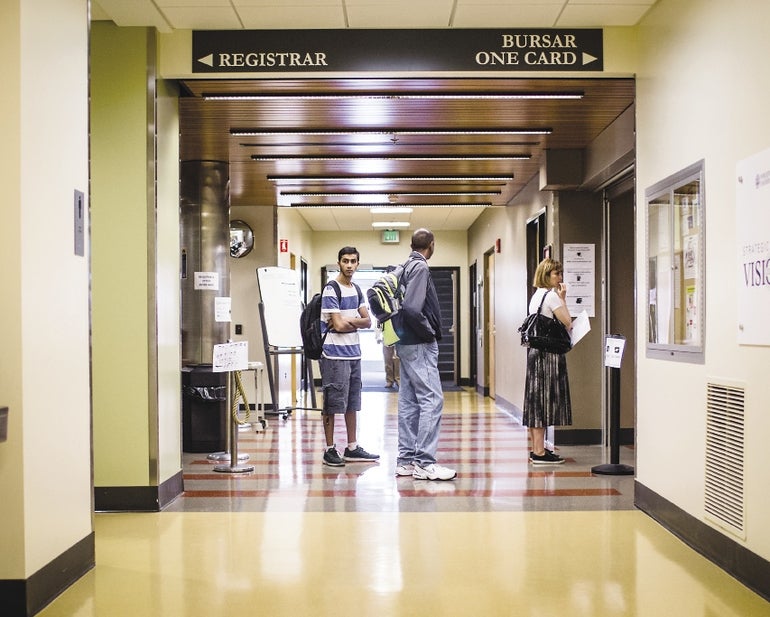The fall semester brings a new class of college students to campuses, but also a new group of students likely to go deep into debt to pay for their classes.
A college degree continues to pay for itself through a career of higher wages than those who don’t have an advanced degree. But paying for college continues to grow far faster than other costs.
Total loan debt for people ages 25 to 34 doubled in the decade ending in 2015, according to California data analytics firm FICO. The number of graduates borrowing more than $50,000 also doubled, and the total amount owed by students is now $1.4 trillion, according to the Consumer Financial Protection Bureau.
“There’s a question over how much longer colleges and universities can keep raising prices,” said John Hamel, the vice president for enrollment management at Anna Maria College in Paxton, where tuition and fees this year topped $51,000.
The graduating class of 2015 in Massachusetts had an average debt of $31,466, the seventh highest in the country, according to the Institute for College Access & Success.
That leaves a spillover effect on the rest of the economy. FICO says those with active student loans are far less likely to also have a mortgage.
Increased financial aid
Certain Central Massachusetts colleges are increasing how much they give in financial aid, even as costs continue rising precipitously.
Worcsester Polytechnic Institute has increased student aid by 9 percent in the past five years, totaling $78 million last year, Executive Direector of Student Aid and Financial Literacy Monica Blondin said
WPI has added more financial literacy classes for students and in August announced $5,000 grants for students to conduct overseas projects.
“We’re extremely aware of the price sensitivity that families have,” Blondin said.
College of the Holy Cross has a need-blind admissions process, in which the college admits students regardless of their financial situation. Holy Cross says it meets 100 percent of students’ demonstrated financial need, and spent $60 million this year on need-based aid.
“It’s always a conversation,” Lynne Myers, Holy Cross’ financial aid director, said of the importance of offering tuition help. “Financial aid competes with all other initiatives.”
That can make enough of a difference, as Holy Cross became cheaper than competing schools elsewhere, and even in-state tuition at the University of Massachusetts.
Junior economics major Vivian Ma of Westborough received more in aid than she said she was expected to receive at Boston College, Providence College and other schools.
“For me, it’s really worth it,” Ma said of the costs.
On the other end of the cost spectrum, public schools like Fitchburg State University and Worcester State University remain relatively affordable options. Like other Massachusetts public colleges, both have steadily risen tuition and fees in part to offset dwindling state aid. But at Worcester State, for example, an in-state commuter student can still attend for just under $10,000 a year, and has increased need-based aid.
“I can tell you, that’s happened every year in recent memory,” said Ryan Forsythe, the school’s vice president for enrollment management. “We’ve dedicated more of that revenue to ensuring those families can afford the education.”
Fitchburg State has given around $42 million a year in aid in recent years — like Worcester State, not a significant increase — and Fitchburg has made it easier for students or families to appeal financial aid decisions if they are in special circumstances, said Denise Brindle, Fitchburg’s director of financial aid.
At Anna Maria College, the high sticker price is offset by an average aid package of $27,000 per student, according to the school. Total aid this year topped $44 million, nearly all of it for financial need. UMass Medical School has increased aid in the past five years from $18 million to $22 million.
College costs eclipse other costs of living
Rising college costs have far outpaced general cost-of-living increases in the past decade. The U.S. Bureau of Labor Statistics reported last year in a 10-year span starting in 2006, college tuition and fees rose by 63 percent. All other items rose only by 21 percent, according to the bureau’s Consumer Price Index.
In a survey last fall, 56 percent of freshmen said they to have some concern about being able to pay for collee, and 13 percent to have major concerns, according to the Higher Education Research Institute at the University of California at Los Angeles.
In 2013, just under half said financial aid was very important in choosing where to go — the highest rate in the 42 years the question was asked. Just under two-thirds said they were admitted to their first-choice college but attended a different school because of the financial aid they were offered.
Slowdown ahead?
At least a few colleges have taken steps in the other direction.
La Salle University in Philadelphia, Sweet Briar College in Virginia and Drew University in New Jersey have each cut tuition by 20 percent or more in the past year.
A broader slowdown could be ahead for the higher education industry.
State lawmakers have begun prohibiting state schools from raising tuition and fees, and some less-selective private schools have found they need to rein in prices to attract more students, said Robert Kelchen, a professor at Seton Hall University in New Jersey who has published research on college costs.
Research shows students are scared off from applying to a college by looking at listed prices, even before finding out what financial aid is available, Kelchen said.
But he doesn’t expect college costs to fall across the board at schools any time soon.
“It’ll be difficult to do in the short term because so much of the costs are labor,” Kelchen said. “As long as students and families tend to value smaller class sizes and going to class in person, it’s hard to bring costs down because those things are very expensive.”

